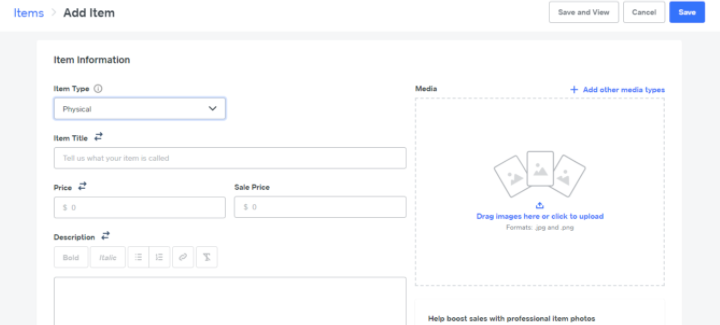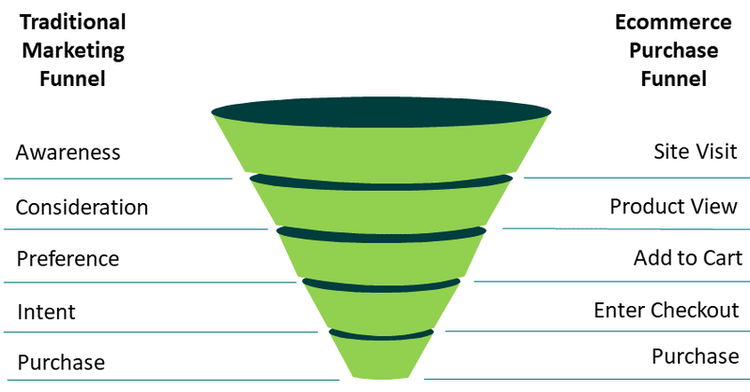E-commerce optimization reconciles the ever-changing needs of retail operations with the dramatically expanding needs of web site operations. Neither retail nor web site operations exist in isolation; they must operate in tandem to achieve true optimization.
Key elements like e-commerce conversion rates, e-commerce marketing plans, retail marketplace optimization, product bundles and pricing strategies all hang precariously in the balance. Bringing all the seemingly disparate pieces together into a cohesive, symbiotic business is a daunting task, but that's the job you've taken on as an online retailer.

When adding a product to your online store, include as many details as possible and create compelling content. Image source: Author
There are many strategies and recommendations to help you achieve and maintain overall e-commerce site optimization. The low-hanging fruit, like choosing the best e-commerce platform for your operation, is essential to setting you up for success. The more difficult wins come from continually managing updates to individual product pages and product descriptions.
Read on to find out more about ecommerce optimization, why it's important, how it can benefit your business, and what you can do to make it happen.
Overview: What is eCommerce optimization?
E-commerce optimization is about profitably combining product, sales, design, experience, marketing, and an endless list of retail and website components. Optimizing your online store and e-commerce strategy is a highly subjective process that is specific to the individual needs of your products, customers, and brand.
Remember, optimization is never a destination, but a journey, a noble quest. Given that today's e-commerce may quickly become tomorrow's, it's important to stay agile and open to new possibilities while constantly striving for optimization.
3 Benefits of Investing in E-Commerce Optimization
There are many assets that e-commerce optimization can bring to your operation. In almost anything you do with an online store, increased sales and revenue are obvious benefits, but to get there, you have to climb a ladder. E-commerce optimization provides some solid rungs on this so-called sales ladder.
Here we will discuss three benefits of ecommerce optimization and how it can impact your online store.
1. Improved user experience
Google is increasingly placing emphasis on user experience as the most important factor in rating websites. This is a significant statement, because almost every component you can add to your site and every bit of code you can tweak impacts the user experience.
Ecommerce optimization places special emphasis on user experience: successful optimization can dramatically improve user experience, positively impacting Google organic traffic, on-page metrics, sales frequency and value, and repeat visitors.
One of the key user experience components that e-commerce optimization impacts is site structure and on-page navigation. How easy is it for a customer to complete a purchase from a product page? What is the experience like adding a product to their cart and then returning to shop again? E-commerce optimization considers and aims to improve these and other important user experience elements.
2. Denser Conversion Funnels
Do you want to increase your online sales? You need to increase your online conversion volume. This means you need to increase the sales rate of your current visitors, increase traffic to your site with a similar sales rate, or increase targeted traffic to a segment that will increase your sales rate. The first two options are fine, but the latter is the most optimal. What is this if not optimization?

Mapping your conversion funnel is essential to successful e-commerce optimization. Image source: Author
A conversion funnel is essentially the e-commerce version of a traditional marketing funnel. A typical conversion strategy has a site visit at the top of the funnel, and as visitors move down the funnel, their intent to buy increases. When visitors make a purchase, they leave the funnel, and when they start shopping on your site again, they return to the funnel.
Ecommerce optimization takes all the necessary steps to drive the right kind of traffic to generate sales conversions for your site. A combination of general visitors and targeted visitors with relevant purchase intent ensures that your conversion funnel maintains a healthy density from top to bottom.
3. Key Performance Indicators for Profitable E-Commerce
An obvious and key benefit of e-commerce optimization is improved metrics, both general KPIs and those specifically related to revenue generation.
While an increase in site visits or an increase in organic and paid media impressions is certainly beneficial for your online business, it doesn't necessarily translate into revenue. While these KPIs should make a difference, and in most cases they do, there are scenarios where you may generate a ton of new traffic but without the corresponding sales. Or, you may see an increase in impressions on your social media posts but no engagement or click-throughs to your site.
What's the value of moving these levers if they're not accompanied by increased sales? Ecommerce optimization ensures you're impacting the right KPIs for real revenue growth.
5 ways to optimize your e-commerce site
Let's take the metaphor of “ladders to increased sales and revenue” further. Here are five techniques for creating and attaching sturdy runs to your sales ladder.
None of these optimizations are one-time projects. They're ongoing tasks that should be the responsibility of your marketing and product leaders primarily. It could be two entire teams, a few people, or even just you. If you're serious about your ecommerce operations, it's worth investing in the talent needed to make ongoing optimization efforts successful.
1. Implement SEO best practices
Search engine optimization (SEO) is a ladder in itself. Comprehensive SEO involves a huge number of elements. Each rung on the SEO ladder helps Google (and other search engines) understand your web page and provide it as satisfying search results for users looking for your target keyword phrases.
Here are three high-level SEO components you need to get right:
- Keyword optimization: The best thing you can do to improve your SEO is to be intentional about the keywords you optimize your pages for. Find related keywords with a good average monthly search volume and optimize around those.
- Metadata: Take the time to include keywords in your crawlable metadata like title tags, alt tags, URLs, etc. Then take the time to create compelling meta descriptions and other non-crawlable assets to drive click-throughs from your organic listings.
- Technical SEO: The back-end performance of your website is the foundation for successful front-end SEO tweaks. All the right optimizations are useless if your pages take 20 seconds to load. Technical SEO includes things like page load times, HTML tagging, clean coding, etc.
2. Iterate on User Design and User Experience
Improved user experience is a key benefit of ecommerce optimization, and realizing improvement requires continuous iteration, testing, and analysis.
The brave new world of website design and digital experiences is constantly unfolding, and you need to stay on top of it to ensure continued success in ecommerce.
This includes simpler components like integrating payments from Apple Pay, but also how the user experiences your site. Are your product pages static? Do they feature videos? Is it an infinite scrolling page? All of these components lead to increased engagement on your page, which can lead to increased sales.
3. Update your product pages, descriptions, and images
You need to make sure that the content you present for each product is accurate and compelling.
Take the time to translate general knowledge about your product into a customized message for your specific audience. Take the time to test different product page designs to understand which ones your visitors respond to best. Also, invest in high-quality images and videos of your product.
Your product pages are the face of your ecommerce business, so making improvements to them will go a long way towards overall optimization.
4. Start an ongoing digital marketing effort
E-commerce isn't a case of “build it and they will come.” You're more like a sheepdog: you need to find your audience and engage them with a message that will lead them to your site or to your specific product.
Digital marketing is a never ending hole Beneficial Listing articles, freemium tools, and “must-have” best practices. They are also essential tools to optimize your ecommerce operations and bring big benefits to your business.

Social platforms cannot be ignored for additional sales channels and new customer acquisition. Image source: Author
You should be doing as much digital marketing as you can, and you should have a plan to expand your marketing efforts when it's possible. Email marketing, social media, advertising, and other programs are all valuable tools for driving meaningful traffic to your site. Take the time to look behind the jargon and test out some different marketing techniques to see which approach really works for your online business.
5. Analyze your site’s performance to determine effective strategies
Your ability to identify and understand e-commerce optimization is directly tied to your reporting and analytics tools. Traffic reports, campaign performance, conversions, sales attribution, and more. All of these reporting tools are your eyes and ears.
It's important to lay the best foundation for future reporting. Set up Google Analytics and take the time to understand exactly what it's telling you. Implement additional attribution tools as needed to track where your customers come from and what messaging brought them to your site. Add performance tools for your social and email campaigns to identify engaging campaigns so you can replicate them in the future.
E-commerce optimization is certainly a lot about trying out different tweaks and strategies and hoping that some of them work. These analytical tools provide details on why they work and how you can make them work even better in the future.
E-commerce optimization is a noble and never-ending quest
You've taken the time to build your online business. It's a big investment and a great start, but launching your site is like standing at the starting line. Once you start optimizing your ecommerce, the gun fires and the race is on. That's when things get real: investments, resources, site traffic, sales.
Work on your e-commerce optimization and do whatever you can to tweak and improve your site. It will either work or it won't. If it doesn't, you'll at least walk away feeling like you did your best. But don't worry, it will work. Your online store will give you years of great optimization pursuits.

